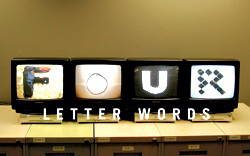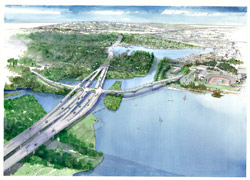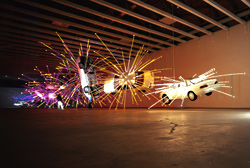I have to admit I was somewhat skeptical when I read the premises of “Shard: Textual Fragments in Contemporary Art,” CoCA’s latest show, and “Eight Essential Ingredients” at Richard Hugo House. Both attempt to unite art and poetry in some meaningful way—a concept that can be either too simple or too complex to be done right and not come across as trite. It’s also potentially redundant: Good poetry is art, and the best art is poetic.
Too often, such challenges prompt disappointingly predictable efforts at layering words over a painted nature scene—as if all poetry drops like snow off the boots of Frost, Wordsworth, or Thoreau, an approach that can come dangerously close to a Hallmark sympathy card. Thankfully, most of the pieces in the CoCA show avoid this, though at Hugo House a video installation flirts with this cliché.
On a visceral level, it’s clear that curator David Francis and the artists of “Shard” have succeeded in capturing the moment and place where text and art merge. When Francis called for entries from both international and Northwest artists, he only asked that their art contain some textual reference. In some of the best examples, that stipulation wasn’t taken too literally: Words are chopped up, torn apart, blurred, bumped against each other underwater, lined up simply on a grocery list, or submerged in oil paint.
Erika Peterson’s small geometric Urn for a Dead Poem contains the ashes of an Emily Dickinson poem. Jon Gierlich and Katerina Fuentes find poetry in the detritus of urban industrial flats in their extensive collage, Seattle Mapping Project, Part I. Smudges of paint are still visible in Robert Campbell’s three photos of sandblasted walls at Fort Worden, frequent magnets for graffiti—a reminder of the tenacity of the need for expression, which dates back at least as far as the caves of Lascaux. Though their words have been effaced for now, the anonymous artists will likely overcome this minor setback and return.
In addition to teaching poetry at Cornish, Francis has a background in archaeology—in many ways the perfect prerequisite for this undertaking. One of his own contributions to the show is one of the most evocative. Untitled Wonder Cabinet is a glass case filled with relics: a bird skull, a box of bones, rusted signs, scraps of poems Francis gathered from the desks of other poets. This is exactly how poetry is made, and of what—a mental excavation of scraps and fragments, remnants of desiccated relationships, symbols whose secrets sometimes can only be unlocked by the author, if at all. This is Francis’ first curatorial foray into a nonarchaeological exhibit, and the segue is seamless.
“Eight Essential Ingredients” at Richard Hugo House is another experiment uniting visual and textual elements, the brainchild of Gabe Kean of Born magazine and Experience Music Project curator Jacob McMurray, with contributions from poet Marvin Bell and a coterie of clever writers. Here the focus is on the process—bring writers and visual artists together, toss in a few ingredients, and see what happens.
The strongest elements of this project are the texts. In Cuckoo’s Nest: An Experiment of Dubious Worth, artful fake Victorian posters by former punk-rock poster designer Mike King were each assigned to a writer who in turn provided a text. The results, reminiscent of the “Exquisite Corpse” parlor games of Tristan Tzara and the dadaists, are very entertaining. Therese Littleton’s cleverly gothic freak-show tale about Neptune’s Greatest Mistake begins enticingly: “After having been twice driven back by unruly crowds of ne’er-do-wells and dockboys, I was at last able to catch a glimpse of the Two-headed Mermaid on display at Pharnum’s Cabinet of Wonders.” Jasen Emmons pens a fake review of a fake extravaganza so absurd it makes you wish it were real: Civil War on Ice!, a six-and-half-hour epic from a pro-Confederate point of view, featuring skater Elvis Stojko as Robert E. Lee.
The collaboration between Steven Berardelli and Marvin Bell, Information From the Forest, includes Bell’s poetry drifting over images of trees on multiple video screens, plus a larger wooden sculpture with a video component. Ultimately, “Eight Essential Ingredients” is a fun, creative effort, while “Shard” taps into something a little deeper—as shards tend to do.








